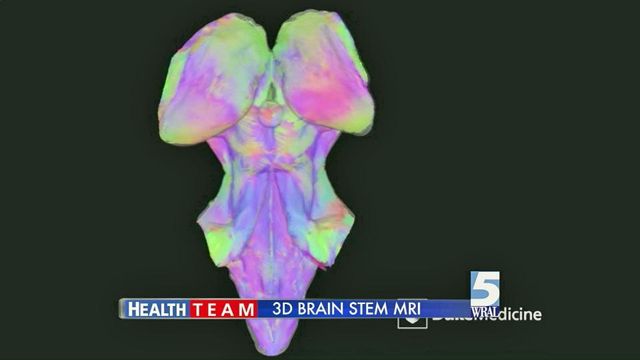Brain imaging breakthrough could improve Parkinson's treatment
The brain is still a mystery, but science is revealing more of its secrets. Scientists at Duke University Hospital are using MRI technology to develop a three-dimensional map of the human brain stem. It gives doctors the highest level of detail ever, and it could improve care for patients who suffer from Parkinson's Disease and tremors.
Posted — UpdatedScientists at Duke University Hospital are using MRI technology to develop a three-dimensional map of the human brain stem. It gives doctors the highest level of detail ever, and it could improve care for patients who suffer from Parkinson's disease and tremors.
Francis Anderson, 66, dealt with tremors so bad that she couldn't complete daily tasks such as drinking, eating or writing.
She recently underwent brain stimulation surgery, where electrodes are inserted into the brain to stimulate a part of the brain stem called the thalamus. The electrodes steady Anderson's tremors.
MRI imaging helps surgeons place the electrodes, but standard images are fuzzy, often making them difficult to place properly.
"It's very hard for us to see the relevant area of the brain directly, so we've been anxious for better ways to do that," Dr. Dennis Turner, a Duke neurosurgeon, said.
That anxious attitude led Duke's Evan Calabrese to build a new three-dimensional model of a cadaver's brain stem. The result was brain scan images with more detail than doctors have ever seen.
Calabrese said the goals are simple. Doctors want to "see some of these small targets that they're trying to hit with deep-brain stimulation," he said.
Calabrese and a team with the Duke Center for In Vivo Microscopy also developed technology to use the MRI imaging in the operating room.
The structures surgeons aim for are smaller than a millimeter. Electrodes covering a wider area can cause side-effects, but more precise placement can reduce them and eliminate the need for repeat procedures.
"That 1 or 2 millimeters can make all the difference, so I think by seeing your target you can place it, not just on a good enough spot but really on an optimal spot the first time," Dr. Nandan Lad, director of Duke's Neuro Outcomes Center, said.
The results of Duke's work were published in the June edition of "Human Brain Mapping," and the advancements are getting a lot of attention around the country.
Duke is already exploring other uses for the technology. They believe imaging could also help doctors treat other parts of the brain stem and illnesses such as depression and Alzheimer's.
• Credits
Copyright 2024 by Capitol Broadcasting Company. All rights reserved. This material may not be published, broadcast, rewritten or redistributed.





